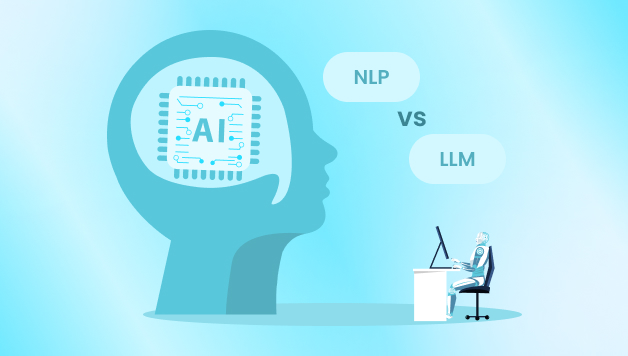As AI continues to evolve, the debate between LLMs vs traditional NLP grows ever more relevant. The shift from rule-based methods of language processing to Generative AI in NLP is transforming how businesses generate content, analyze data, and create personalized experiences for users. In this article, we explore the differences between LLM vs NLP, particularly in the context of AI writing, and how each is likely to impact the future of content creation.
What Are Traditional NLP Models?
Traditional NLP models are based on structured, rule-based systems designed to process language through pre-programmed algorithms and linguistic rules. These models typically perform tasks such as:
- Text classification for spam filtering or sentiment analysis
- Named Entity Recognition (NER) for identifying key entities in text
- Part-of-Speech Tagging to identify the grammatical roles of words
Traditional NLP relies heavily on statistical methods and predetermined linguistic rules, offering high precision for specific tasks. However, these models are limited in scope and unable to generate new content or adapt to complex, varied language inputs.
The Rise of LLMs (Large Language Models)
In contrast, LLM vs NLP introduces a more dynamic approach. Large Language Models like OpenAI’s GPT-3, are designed to generate text that is contextually relevant and human-like. These models are trained on vast datasets, enabling them to:
- Generate content with coherence and fluency
- Perform tasks with minimal supervision, such as summarization or translation
- Handle complex queries by using context learned from large volumes of text data
The key difference between LLMs vs traditional NLP lies in the ability of LLMs to produce creative, novel outputs instead of merely analyzing existing data.
How LLMs are Shaping the Future of AI Writing
LLMs for SEO Content
One of the most impactful applications of LLMs is in SEO content creation. Traditional NLP models may be effective at keyword analysis and basic content classification, but LLMs for SEO content can generate long-form, contextually rich articles that are optimized for search engines. By analyzing large datasets and understanding complex language patterns, LLMs can:
- Generate SEO-optimized text that incorporates relevant keywords naturally
- Create content variations to cater to different audiences and contexts
- Improve user engagement through content that mimics human-written style
This makes LLMs an indispensable tool for content creators, digital marketers, and SEO professionals looking to stay ahead of the curve.
Speed and Scalability
In addition to content quality, LLMs are a powerful tool for scaling content creation. While traditional NLP models require manual programming for each new application, LLMs can be adapted to multiple tasks with minimal intervention. This scalability makes LLMs particularly appealing for businesses that need large volumes of content, such as e-commerce websites, blogs, and news outlets.
Traditional NLP vs LLMs: Strengths and Limitations
When comparing Traditional NLP vs LLMs, both approaches have distinct strengths and challenges.
Strengths of Traditional NLP
- Precision: Traditional NLP models offer high accuracy in structured tasks like classification and tagging.
- Transparency: They provide clear, understandable reasoning behind their outputs.
- Efficiency: These models can process language quickly without needing large computational resources.
Strengths of LLMs
- Flexibility: LLMs excel at tasks like content generation, answering questions, and conversational AI.
- Creativity: They can produce creative and nuanced outputs that mimic human language.
- Adaptability: LLMs can be fine-tuned for specific applications, making them versatile across various industries.
Challenges
- Computationally Expensive: LLMs require significant computational power, which can be costly.
- Lack of Transparency: The decision-making process within LLMs is often difficult to interpret.
- Bias in Training Data: Like any machine learning model, LLMs can inherit biases present in their training datasets.
The Role of AI Consulting Companies
As organizations strive to leverage LLMs vs traditional NLP, many are turning to AI consulting company, for guidance. These companies help businesses integrate AI into their content generation processes by offering:
- Customization of LLMs for specific needs
- Optimization of content for SEO and user engagement
- Ethical frameworks for minimizing bias in AI-generated content
AI consulting companies can also assist in training teams to effectively use these advanced models and maintain high standards in AI-generated content.
Conclusion: LLMs vs Traditional NLP – A Hybrid Future
The future of AI writing doesn’t lie in choosing LLMs vs traditional NLP—it lies in combining the strengths of both. LLMs for SEO content and Generative AI in NLP are revolutionizing the landscape of AI writing, providing unprecedented flexibility, creativity, and scalability. However, traditional NLP models still have their place, especially when precision and transparency are required.
In the evolving field of AI, businesses can rely on AI consulting companies to build hybrid systems that combine the best of LLMs vs traditional NLP, ensuring the right solution for every application. As these technologies continue to develop, the future of AI writing promises to be more efficient, creative, and adaptive than ever before.

